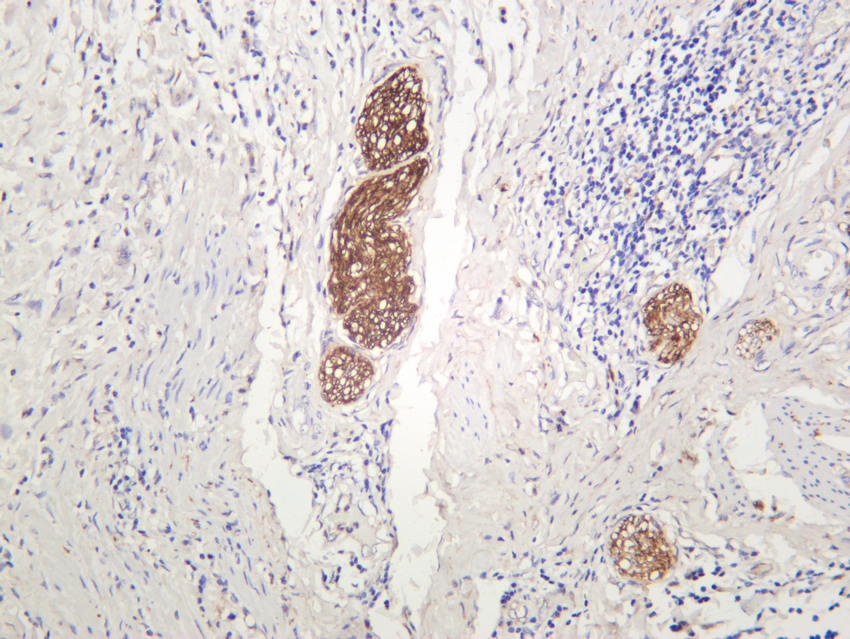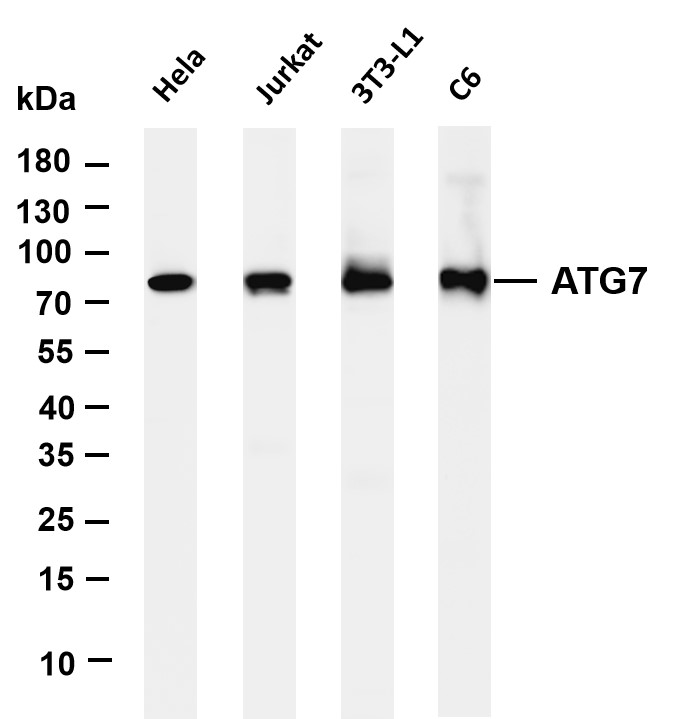ATG7 (PT0335R) PT® Rabbit mAb
- Catalog No.:YM8198
- Applications:WB;IHC;IF;IP;ELISA
- Reactivity:Human; Mouse; Rat;
- Target:
- APG7
- Fields:
- >>Autophagy - other;>>Autophagy - animal;>>Ferroptosis;>>Neutrophil extracellular trap formation
- Gene Name:
- ATG7 APG7L
- Protein Name:
- Ubiquitin-like modifier-activating enzyme ATG7 (ATG12-activating enzyme E1 ATG7) (Autophagy-related protein 7) (APG7-like) (hAGP7) (Ubiquitin-activating enzyme E1-like protein)
- Human Gene Id:
- 10533
- Human Swiss Prot No:
- O95352
- Mouse Swiss Prot No:
- Q9D906
- Rat Swiss Prot No:
- Q641Y5
- Specificity:
- endogenous
- Formulation:
- PBS, 50% glycerol, 0.05% Proclin 300, 0.05%BSA
- Source:
- Monoclonal, rabbit, IgG, Kappa
- Dilution:
- IHC 1:200-1:1000,WB 1:1000-1:5000,IF 1:200-1:1000,ELISA 1:5000-1:20000,IP 1:50-1:200,
- Purification:
- Protein A
- Storage Stability:
- -15°C to -25°C/1 year(Do not lower than -25°C)
- Other Name:
- Ubiquitin-like modifier-activating enzyme ATG7 (ATG12-activating enzyme E1 ATG7;Autophagy-related protein 7;APG7-like;hAGP7;Ubiquitin-activating enzyme E1-like protein)
- Molecular Weight(Da):
- 78kD
- Observed Band(KD):
- 78kD
- Background:
- This gene encodes an E1-like activating enzyme that is essential for autophagy and cytoplasmic to vacuole transport. The encoded protein is also thought to modulate p53-dependent cell cycle pathways during prolonged metabolic stress. It has been associated with multiple functions, including axon membrane trafficking, axonal homeostasis, mitophagy, adipose differentiation, and hematopoietic stem cell maintenance. Alternative splicing results in multiple transcript variants. [provided by RefSeq, Sep 2015],
- Function:
- domain:The C-terminal part of the protein is essential for the dimerization and interaction with ATG3 and ATG12.,function:Functions as an E1 enzyme essential for multisubstrates such as GABARAPL1 and ATG12. Forms intermediate conjugates with GABARAPL1 (GABARAPL2, GABARAP or MAP1ALC3). Formation of the final GABARAPL1-PE conjugate is essential for autophagy.,similarity:Belongs to the ATG7 family.,subunit:Homodimer (By similarity). Interacts with ATG3 and ATG12. The complex, composed of ATG3 and ATG7, plays a role in the conjugation of ATG12 to ATG5.,tissue specificity:Widely expressed, especially in kidney, liver, lymph nodes and bone marrow.,
- Subcellular Location:
- Cytoplasm
- Expression:
- Widely expressed, especially in kidney, liver, lymph nodes and bone marrow.
PTH1-34 promotes osteoblast formation through Beclin1-dependent autophagic activation. JOURNAL OF BONE AND MINERAL METABOLISM J Bone Miner Metab. 2021 Jul;39(4):572-582 WB Mouse MC3T3-E1 cell
PTH1-34 promotes osteoblast formation through Beclin1-dependent autophagic activation. JOURNAL OF BONE AND MINERAL METABOLISM J Bone Miner Metab. 2021 Jul;39(4):572-582 WB Mouse MC3T3-E1 cell
- June 19-2018
- WESTERN IMMUNOBLOTTING PROTOCOL
- June 19-2018
- IMMUNOHISTOCHEMISTRY-PARAFFIN PROTOCOL
- June 19-2018
- IMMUNOFLUORESCENCE PROTOCOL
- September 08-2020
- FLOW-CYTOMEYRT-PROTOCOL
- May 20-2022
- Cell-Based ELISA│解您多样本WB检测之困扰
- July 13-2018
- CELL-BASED-ELISA-PROTOCOL-FOR-ACETYL-PROTEIN
- July 13-2018
- CELL-BASED-ELISA-PROTOCOL-FOR-PHOSPHO-PROTEIN
- July 13-2018
- Antibody-FAQs
- Products Images

- Human cervical carcinoma was stained with anti-ATG7 (PT0335R) rabbit antibody

- Various whole cell lysates were separated by 4-20% SDS-PAGE, and the membrane was blotted with anti- ATG7 (PT0335R) antibody. The HRP-conjugated Goat anti-Rabbit IgG(H + L) antibody was used to detect the antibody. Lane 1: Hela Lane 2: Jurkat Lane 3: 3T3-L1 Lane 4: C6 Predicted band size: 78kDa Observed band size: 78kDa



